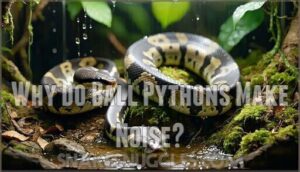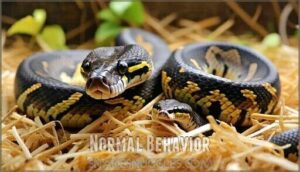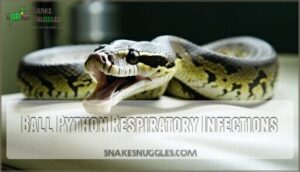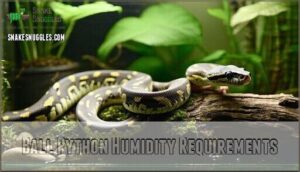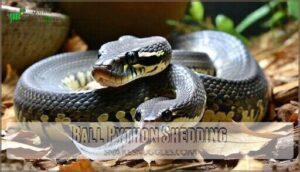This site is supported by our readers. We may earn a commission, at no cost to you, if you purchase through links.
 Ball pythons do make noise, though they’re not exactly chatty creatures.
Ball pythons do make noise, though they’re not exactly chatty creatures.
You’ll hear them produce several distinct sounds including soft puffing during shedding, gentle squeaking when moving, occasional hissing when defensive, and digestive gurgles after meals.
Most sounds are perfectly normal parts of their daily routine.
However, respiratory noises like wheezing or clicking can signal health issues such as infections or humidity problems that need your attention.
These snakes communicate through body language too, but their vocalizations tell you plenty about their well-being.
Understanding what each sound means helps you spot the difference between normal behavior and potential concerns, and is crucial for identifying issues like infections or humidity problems.
Table Of Contents
- Key Takeaways
- Types of Noises Ball Pythons Make
- Why Do Ball Pythons Make Noise?
- Ball Python Puffing Behavior
- Ball Python Respiratory Infections
- Ball Python Humidity Requirements
- Ball Python Shedding
- Respiratory Infection in Snakes
- Finding a Reptile Veterinarian
- Ball Python Communication
- Other Ways Snakes Communicate
- Frequently Asked Questions (FAQs)
- Do ball pythons make any noise?
- How do I know if my ball python is happy?
- Why do ball pythons wheeze?
- Will a ball python strike at you?
- Why is my ball python making a noise?
- Do ball pythons hear sound?
- Why is my ball python puffing at me?
- Why is my ball python whistling?
- Are ball pythons noisy?
- Can ball pythons hear?
- Conclusion
Key Takeaways
- You’ll hear normal sounds like soft puffing during shedding, gentle squeaking when moving, occasional hissing when defensive, and digestive gurgles after meals – these are all part of your ball python’s daily routine.
- You need to watch for respiratory noises like wheezing or clicking, which signal health issues such as infections or humidity problems that require immediate veterinary attention.
- You must maintain humidity levels between 50-60% in your python’s enclosure to prevent respiratory distress and the squeaking sounds that indicate stress or breathing difficulties.
- You can distinguish between normal communication (like hissing when threatened) and concerning symptoms by monitoring your snake’s breathing patterns, appetite, and overall behavior alongside any vocalizations.
Types of Noises Ball Pythons Make
Ball pythons produce several distinct types of sounds that range from normal bodily functions to warning signals.
From squeaks to hiss warnings—your ball python’s soundtrack reveals everything about their health and mood.
You’ll hear excretory noises during defecation, digestive sounds from gas movement, respiratory noises like wheezing or clicking, and miscellaneous sounds including hissing and rustling during shedding.
Excretory Noises
Ball pythons produce surprising excretory noises during waste elimination.
You’ll hear cloacal popping sounds and occasional urate sounds when they defecate every 4-6 weeks.
These ball python sounds come with fecal odors that indicate normal digestive health.
A healthy gut microbiome creates these natural reptile noises.
Listen for these snake noises to monitor your python’s well-being.
Digestive Noises
Your ball python’s gut sounds might catch you off guard during digestion.
These digestive sounds range from soft rumbling to occasional gurgling as their stomach processes meals.
Feeding frequency affects noise intensity – larger prey creates more pronounced sounds.
Normal digestive health produces these intermittent noises, though unusual patterns could indicate substrate impaction or other concerns requiring attention.
Respiratory Noises
Regarding respiratory noises, your ball python might produce wheezing, clicking, or rattling sounds.
These snake sounds often indicate respiratory issues or respiratory infections requiring immediate attention.
Environmental impact from low humidity creates atypical sounds.
Infection severity varies, but persistent wheezing suggests serious problems.
Preventative measures include proper humidity control.
Genetic predisposition makes some snakes more vulnerable to breathing difficulties.
Miscellaneous Noises
Beyond breathing troubles, you’ll encounter other fascinating snake sounds during regular activities.
These normal sounds help with identifying sounds that signal healthy behavior versus concerning issues.
Your python creates these everyday snake noises:
- Drinking gurgling – Normal swallowing sounds at water bowls
- Bubble blowing – Playful water interaction indicating comfort
- Shedding rustling – Natural movement against substrate during skin renewal
- Defensive hissing – Warning vocalization when startled
Understanding these ball python vocalizations prevents unnecessary worry about python noises.
Why Do Ball Pythons Make Noise?
Your ball python makes noise for several important reasons that signal changes in their health or environment.
These sounds often indicate issues like airway blockages, low humidity levels, respiratory infections, or the natural shedding process that requires your attention.
Airway Obstruction
When your snake’s airway gets blocked, you’ll hear troubling sounds that demand immediate attention.
Shed debris clinging to nostrils, substrate irritation from dusty bedding, or feed impaction can trigger respiratory distress and wheezing.
These obstructions create breathing difficulties and increase aspiration risk, making preventative measures absolutely essential for your python’s health.
| Obstruction Type | Warning Signs |
|---|---|
| Shed Debris | Whistling, labored breathing |
| Substrate Irritation | Persistent wheezing sounds |
| Feed Impaction | Gurgling, mucus discharge |
| Foreign Objects | Clicking, rattling noises |
| Mucus Buildup | Heavy breathing patterns |
Low Humidity
Dry air creates serious problems for your ball python’s health.
When humidity drops below proper levels, your snake’s respiratory system struggles.
Dry air effects include squeaking sounds and labored breathing.
Poor Enclosure Misting leads to Shedding Issues and ball python hissing.
Hydration Importance can’t be overstated – low moisture triggers snake hissing and compromises Respiratory Health quickly.
Respiratory Infections
When your ball python starts wheezing or producing mucus, respiratory infections might be the culprit.
These infections can be viral infections, fungal infections, or bacterial, often triggered by poor humidity or dirty conditions.
You’ll notice labored snake breathing and possible ball python hissing.
Nebulization therapy and antibiotics help treat these issues, but infection prevention through proper care beats dealing with antibiotic resistance later.
Shedding
The shedding process brings noticeable changes in your ball python’s behavior.
You’ll hear increased squeaking and puffing as they prepare for healthy shedding.
These sounds indicate normal snake behavior during their shedding frequency cycle.
- Skin becomes milky and eyes turn blue
- Snake seeks rough surfaces for stuck shed removal
- Increased hiding and reduced appetite occurs
Maintain proper humidity as natural shedding aid.
Ball Python Puffing Behavior
You’ll notice your ball python puffs up during normal daily activities and this behavior isn’t cause for concern.
Their skin’s natural elasticity allows them to expand and contract as they breathe, move, or adjust their body position in the enclosure, which is a normal process related to their breathing.
Normal Behavior
Throughout their shedding cycle, you’ll notice your ball python becomes puffed up more often.
This ball python behavior represents normal snake communication—they’re stretching their skin before molting.
During this period, python sounds may include soft puffing noises.
However, monitor their activity levels and appetite changes closely.
If handling tolerance decreases or sleeping patterns shift dramatically, check environmental moisture.
Dry air can transform normal snake noises meaning comfort into signals of respiratory distress.
Elasticity in Skin
Understanding puffing behavior leads us to explore how skin elasticity makes these sounds possible.
Your ball python’s remarkable skin can stretch up to 20% beyond its normal size during puffing episodes.
This scale flexibility isn’t just for show—it’s essential for the shedding process and snake molting cycles.
When your python inflates its body, the elastic snake skin creates those distinctive whooshing sounds.
Skin hydration affects this elasticity, with well-hydrated snakes producing clearer sounds.
Age effects also play a role, as younger pythons typically have more flexible skin.
This natural injury repair mechanism helps your snake communicate effectively without physical confrontation.
Ball Python Respiratory Infections
You’ll notice your ball python making unusual wheezing or gurgling sounds when they develop a respiratory infection.
These infections cause serious breathing problems that require immediate veterinary care to prevent complications, and it’s crucial to address them promptly to ensure the best outcome for your pet.
Symptoms
When breathing difficulty crops up in your ball python, you’ll spot telltale warning signs.
Respiratory issues don’t hide well in these reptiles.
- Lethargy signs – Your snake becomes unusually inactive and sluggish
- Mucus discharge – Clear or colored fluid appears around nostrils
- Unusual sounds – Wheezing, clicking, or squeaking during normal breathing
- Appetite changes – Refusing food or showing decreased interest in meals
Causes
When ball python respiratory infections develop, several stress factors and enclosure issues typically trigger the problem.
Poor humidity levels, temperature fluctuations, and dirty substrates create environmental triggers that weaken your snake’s immune system.
Handling stress from excessive interaction compounds these health problems.
Understanding these snake noise causes helps you identify when respiratory issues need attention before they worsen substantially.
Treatment
Professional respiratory infection treatment requires immediate veterinary intervention.
Your reptile vet will develop a targeted treatment plan based on your snake’s specific condition.
They’ll typically prescribe:
- Antibiotics – Combat bacterial infections effectively
- Mucolytics – Break down stubborn mucus buildup
- Nebulization therapy – Clear blocked airways safely
Veterinary follow-up appointments guarantee proper recovery progress monitoring.
Low humidity can cause respiratory and shedding issues.
Home Care
Once your vet prescribes treatment, home care becomes your responsibility.
Keep humidity levels between 50-60% and maintain proper temperature control in the enclosure.
Follow a strict cleaning schedule to prevent reinfection.
Monitor your python’s breathing daily and continue prescribed nebulization treatments.
Proper substrate choice and enclosure size support recovery while reducing snake stress management needs.
Maintaining proper humidity may require a reptile humidifier purchase.
Proper care includes maintaining the right environment, which is crucial for your python’s recovery and overall health, and managing humidity levels correctly.
Ball Python Humidity Requirements
You’ll need to maintain humidity levels between 50-60% in your ball python’s enclosure to prevent respiratory issues that cause noisy breathing.
Dry air makes your snake work harder to breathe and can trigger the squeaking sounds that indicate stress or health problems.
Ideal Humidity Range
Your ball python’s comfort zone sits between 50-60% humidity.
This sweet spot prevents respiratory infections while avoiding scale rot.
Here’s what proper humidity monitoring delivers:
- Healthy shedding cycles – No more stuck shed pieces
- Clear breathing – Reduced risk of respiratory distress
- Natural python communication – Normal hissing and movement patterns
Maintaining these hydration levels supports your snake’s overall well-being and enclosure success.
Accurate readings require a reliable python hygrometer.
Measuring Humidity
Hygrometer selection makes all the difference in monitoring your ball python’s environment.
Digital hygrometers provide accurate readings and easy calibration, while analog hygrometers offer budget-friendly alternatives.
Place humidity probes at snake level for precise measurements. Most digital models self-calibrate, but analog types need manual adjustment.
Consider purchasing digital options for enhanced accuracy. Position your device away from water bowls to avoid false readings.
Dry Air Effects
When humidity drops below 50%, your ball python faces serious health risks.
Dry air creates a cascade of problems that can quickly spiral out of control.
- Dehydration Risks – Your snake’s body loses moisture faster than it can replenish
- Shedding Problems – Stuck shed pieces can cut off circulation or cause infections
- Respiratory Issues – Dry airways become irritated and prone to respiratory infections
- Skin Health – Cracked, damaged skin provides entry points for bacteria
- Humidity Control – Proper levels prevent most ball python behavior problems
Ball Python Shedding
You’ll notice your ball python makes more squeaking and puffing sounds when it’s preparing to shed its skin.
These noises are completely normal during the shedding process and indicate your snake’s respiratory system is working harder as its body prepares for this natural cycle, which can be identified by the distinct squeaking sounds.
Squeaking and Puffing
Your ball python’s squeaking and puffing during shedding isn’t cause for alarm. These python behavior patterns are normal stress indicators that occur when your snake prepares to shed its skin. The sounds help loosen old skin naturally.
However, handling effects can worsen these symptoms. Enclosure issues like improper humidity may intensify squeaking. Monitor hydration levels carefully during this period. Ball pythons can experience shedding problems if humidity levels are too low.
| Normal Shedding Signs | Concerning Symptoms |
|---|---|
| Light squeaking sounds | Persistent wheezing |
| Occasional puffing | Open-mouth breathing |
| Milky eyes | Excessive mucus discharge |
Preventative measures include maintaining proper humidity and minimizing snake vocalization through reduced handling. This ball python behavior typically resolves once shedding completes.
Monitoring Symptoms
Like a detective examining clues, you’ll need to watch for specific behavior changes during your snake’s shedding cycle. Appetite tracking becomes essential as your python may refuse food for several days.
Monitor these key symptoms during shedding:
- Reduced appetite and food refusal
- Restlessness and increased movement
- Extended soaking sessions in water bowls
- Squeaking and puffing respiratory sounds
- Cloudy, milky eyes indicating pre-shed phase
Maintain 50-60% humidity levels and watch breathing patterns carefully. Any open-mouth breathing signals potential respiratory issues requiring immediate attention, especially if you notice cloudy, milky eyes or reduced appetite.
Respiratory Infection in Snakes
After your ball python’s shed, watch for respiratory infections that can sneak up without warning.
These infections affect your snake’s breathing and overall health. Early detection prevents serious complications. Copious frothy discharge can be a sign of a serious respiratory issue.
| Infection Type | Primary Symptoms | Treatment Approach |
|---|---|---|
| Bacterial | Mucus discharge, wheezing | Antibiotics, nebulization therapy |
| Viral Pneumonia | Open-mouth breathing, lethargy | Supportive care, humidity control |
| Fungal Infections | Respiratory issues, nasal discharge | Antifungal medication, environmental changes |
| Mixed Infections | Combined symptoms | Thorough treatment plan |
| Secondary Infections | Weakened immune response | Infection Prevention protocols |
Your vet will prescribe appropriate antibiotics while avoiding antibiotic resistance through proper dosing. Nebulization therapy helps clear airways effectively. Maintain ideal humidity and temperature to support recovery and prevent future respiratory problems.
Finding a Reptile Veterinarian
You’ll need to locate a qualified reptile veterinarian when your ball python shows signs of respiratory infection or unusual breathing sounds.
Start by searching the Association of Reptile and Amphibian Veterinarians database within your area to find specialists with proven experience treating snakes.
Association of Reptile and Amphibian Veterinarians
When seeking specialized care for your ball python’s respiratory issues or unusual python vocalizations, the Association of Reptile and Amphibian Veterinarians (ARAV) serves as your go-to veterinarian directory.
This professional network connects you with qualified vets who understand reptile sounds and python behavior.
ARAV membership benefits include:
- Reptile expertise – Vets trained specifically in snake respiratory care
- Amphibian specialists – Professionals who understand unique reptile needs
- Find qualified vets – Easy access to experienced practitioners
- Specialized knowledge – Understanding of python vocalizations and behavior patterns
Search by Radius
When searching for reptile Local Vets, use the ARAV website’s radius feature to locate qualified professionals within your Specialist Radius.
Set your search distance based on Emergency Care needs and transportation availability. Consider Breeder Distance recommendations and Rescue Search networks for referrals.
A good vet will also understand reptile environmental needs.
Finding the right vet for ball pythons requires balancing proximity with expertise in python behavior and respiratory health concerns.
Experience in Reptile Care
When choosing a veterinarian, their reptile care experience directly impacts your ball python’s health outcomes. A seasoned professional understands python behavior, hissing patterns, and respiratory symptoms that general vets might miss.
Look for these qualifications:
- Handling Techniques – Proper restraint methods for stressed snakes
- Health Monitoring – Experience diagnosing respiratory infections and shedding issues
- Behavior Observation – Understanding normal versus concerning python communication
- Enclosure Enrichment – Knowledge of humidity requirements and environmental factors
Ball Python Communication
You’ll discover that ball pythons communicate through specific sounds that serve important purposes in their daily lives.
These snakes use hissing as their primary warning signal and produce several other vocalizations to express stress, defend territory, or respond to environmental changes, which is a key part of their communication.
Hissing
Ball pythons break out defensive hissing when they feel threatened or stressed.
This python communication method varies in hissing frequency and hissing intensity based on the situation.
Juvenile hissing often sounds sharper than adult vocalizations. The hissing context matters—sudden movements or handling during rest triggers this reptile hissing response.
Python hissing serves as their primary warning signal before defensive actions.
Rattling
Unlike other snakes, ball pythons don’t actually rattle.
What you’re hearing might be respiratory issues causing unusual breathing sounds.
These enclosure vibrations often stem from respiratory infections or stress responses.
Your snake’s temperament influence how they react to perceived threats.
Prevention methods include maintaining proper humidity and temperature.
If you notice persistent rattling sounds, schedule a veterinary examination for proper snake noise analysis.
Bellowing
Bellowing sounds represent your ball python’s most dramatic vocal cord expression through forceful air expulsion. This rare defensive mechanism creates a deep, resonant warning that’s louder than typical hissing or squeaking.
Understanding these vocalizations helps with proper snake noise interpretation during stressful encounters.
- Threat display during territorial disputes
- Stress response to handling or disturbance
- Mating season communication attempts
- Emergency warning before striking behavior
Growling
True growling rarely occurs in ball pythons, making it one of their rarest snake vocalizations.
When you hear defensive growling, it’s actually a low-frequency variation of hissing combined with body vibrations.
These growl variations signal extreme stress or territorial behavior.
Unlike typical squeaking sounds, growling origins stem from deep respiratory chambers, creating a rumbling effect that mimics mammalian growls through specialized airflow patterns.
Additional Sounds
Beyond growling, your ball python produces several unusual vocalizations that might surprise you.
These audible clicks, gurgling sounds, and bubble blowing behaviors serve specific communication purposes.
You’ll notice rustling scales during movement, occasional squeaking when stressed, and various snake noise patterns during feeding or shedding cycles.
- Clicking sounds – Often occur during tongue flicking or jaw adjustments
- Gurgling noises – May indicate digestive processes or respiratory activity
- Bubble blowing – Sometimes happens when drinking or during humid conditions
- Scale rustling – Natural friction sounds during body movements and positioning
- Stress vocalizations – Include soft hissing variations and breathing pattern changes
Other Ways Snakes Communicate
While ball pythons don’t rely heavily on sounds to communicate, they use several body language signals to express their feelings and intentions.
You’ll notice your snake extending its height to appear larger when threatened, inflating its head to show dominance, curling into a tight ball for protection, or even playing dead when extremely stressed.
Extending Height
When ball pythons extend their height, they’re checking out their world like a periscope.
This body language signals curiosity and alertness about their surroundings.
Your snake might stretch up to investigate new scents or sounds in their enclosure size.
Proper vertical enrichment and climbing opportunities in habitat design encourage this natural behavior, helping optimize space and reduce stress-related vocalizations like hissing or squeaking.
Inflating Head
When your ball python feels threatened, it inflates its head as a defensive mechanism to appear more intimidating.
This snake anatomy adaptation works alongside other defensive behaviors:
- Hissing – Creates audible warning sounds
- Body positioning – Raises head higher for maximum impact
- Territorial displays – Shows intent to protect territory
Head inflation causes include stress, handling, or perceived threats.
Monitor inflation frequency to identify potential complications.
Curling Up
When threatened, ball pythons instinctively adopt a defensive posture by curling up into tight coils.
This body language signals stress and creates security seeking behavior in their enclosure.
The muscle tension helps with thermoregulation while protecting essential organs.
Unlike hissing or squeaking, curling up serves as silent communication that precedes more aggressive displays when your snake feels cornered.
Playing Dead
When your ball python’s death feigning kicks in, you’ll witness complete muscular relaxation and motionless positioning.
This defensive behavior represents an evolutionary advantage – a survival tactic that confuses predators.
Playing dead occurs during extreme snake stress from improper snake handling or environmental threats.
This predator avoidance strategy showcases your snake’s remarkable instinctual responses to perceived danger.
Frequently Asked Questions (FAQs)
Do ball pythons make any noise?
Yes, your ball python can make several sounds.
You’ll hear hissing when they’re threatened, squeaking from stress, wheezing during shedding, and occasional breathing sounds.
Most noises indicate normal behavior or environmental needs, which can include stress related issues.
How do I know if my ball python is happy?
Like a content cat basking in sunlight, a happy ball python displays calm body language, regular eating habits, and consistent shedding cycles.
You’ll notice relaxed coiling, steady breathing, and comfortable exploration of their enclosure environment, which are all signs of a happy ball python.
Why do ball pythons wheeze?
Wheezing in your ball python typically signals respiratory distress from low humidity, respiratory infections, or shedding complications.
You’ll need to check humidity levels and watch for other symptoms like open-mouth breathing, which can indicate a serious issue such as respiratory infections.
Will a ball python strike at you?
Ball pythons can strike if they feel threatened, stressed, or mistake your hand for food.
They’ll usually hiss first as a warning.
Proper handling techniques and calm movements reduce strike risk substantially.
Why is my ball python making a noise?
Several factors could explain your snake’s vocalizations.
Hissing indicates stress or feeling threatened.
Wheezing suggests respiratory issues or shedding.
Squeaking often signals improper humidity levels or handling stress requiring immediate attention.
Do ball pythons hear sound?
Yes, your ball python can hear sounds, but not like you do.
They detect low-frequency vibrations through their jawbone and skull, picking up sounds between 80-1000 Hz rather than airborne voices.
Why is my ball python puffing at me?
Your ball python’s puffing likely signals stress, respiratory infection, or shedding preparation.
Check humidity levels, enclosure cleanliness, and temperature.
If puffing continues with lethargy or discharge, consult a reptile veterinarian immediately.
Why is my ball python whistling?
When there’s smoke, there’s fire – your ball python’s whistling typically indicates respiratory distress or overexertion.
Check humidity levels, make certain proper temperatures, and watch for labored breathing that might require veterinary attention.
Are ball pythons noisy?
Generally, ball pythons aren’t noisy pets.
They’re naturally quiet creatures that rarely make sounds during normal activities.
You’ll occasionally hear hissing when they’re stressed, but they won’t disturb your household like other animals.
Can ball pythons hear?
Your ball python can hear sounds between 80-1000 Hz through ground vibrations and their jawbone.
They detect low-pitched, bass-like sounds but can’t hear your voice.
They’re more sensitive to vibrations than airborne sounds.
Conclusion
Remarkably, ball pythons aren’t silent creatures after all.
You now know the seven surprising sounds these snakes make, from normal digestive gurgles to concerning respiratory wheezes.
Regular monitoring helps you distinguish between healthy sounds and warning signs of illness.
When respiratory noises persist, contact a reptile veterinarian immediately.
Remember that humidity levels directly affect your python’s breathing patterns.
Understanding whether ball pythons make noise empowers you to provide better care and catch health issues early with the help of respiratory monitoring.
- https://reptilesmagazine.com/the-vet-report-contrary-to-popular-belief-snakes-can-hear/
- https://animals.sandiegozoo.org/animals/python
- https://www.arav.org/
- https://ball-pythons.net/forums/showthread.php?169893-Snake-making-an-odd-noise
- https://www.pangeareptile.com/forums/forum/all-reptiles/snakes/34353-my-ball-python-is-whistling

